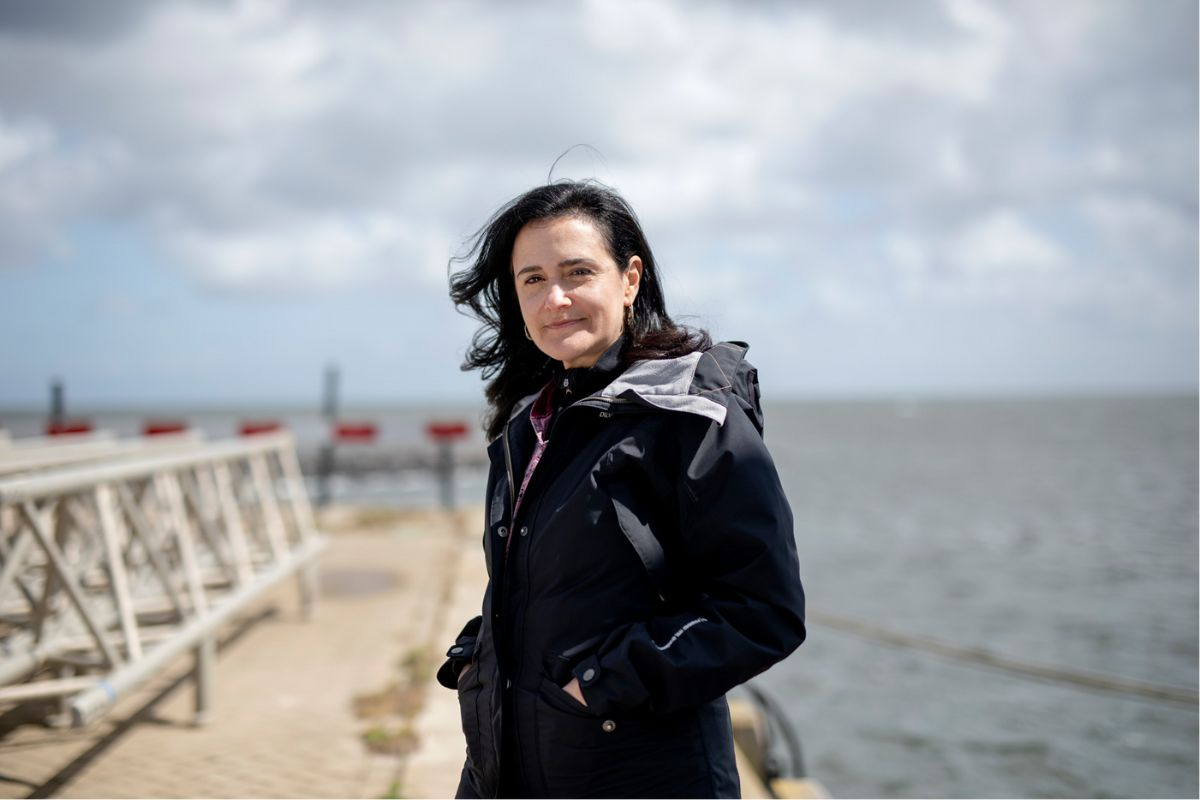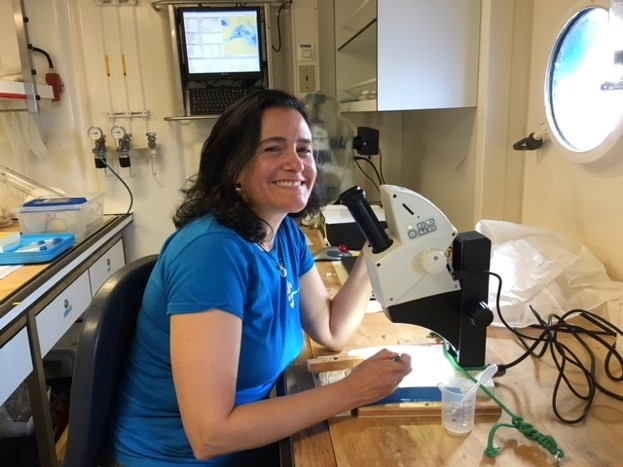Prestigious European grant for research into biodegradable plastics

Vibrant sea
For the next five years, Amaral-Zettler, together with three PhD-candidates and lab analysts, will work on the project she creatively calls ‘ViBRANT-SEA’, the acronym for her project entitled: Validating Biodegradation Rates and Reactions Applying Novel Technologies and Systems Ecology Approaches. “Above all, with this project we want to emphasize how vibrant the marine ecosystem still is and how we should keep it that way.”
Who biodegrades the biodegradables?
The project is divided in three so-called work-packages. “In the first, we want to identify who is breaking down the biodegradables. We will look for novel microbes, but also for specific genes in these microbes, that encode the enzymes that are necessary for biodegradation of the main components of two biodegradable polymers we will concentrate on: polyhydroxyalkanoates and polylactic acid. In the meantime, we may also find pathways that produce these polymers, because many microbes that break down biodegradable plastics, are also able to produce them”, Amaral-Zettler explains.
How fast do they break down?
In a second work-package, Amaral-Zettler and her team hope to find out how fast – or how slow – the biodegradable plastics break down into carbon dioxide, water and biomass. “We will establish that both in the lab, as well as under field conditions, using plastic with labeled carbon. Biodegradation under the high pressures and low temperatures of the deep sea, may be something entirely different than under conditions on land. And unfortunately, much of our plastics end up in the deep sea.”
Without lab animals
In a third work-package, Amaral-Zettler intends to collaborate with Bart Spee, expert at so-called organoids at Utrecht University, to design an organoid, or an artificial organ of a marine fish in a petri dish. “At the moment, the mandatory testing of ecotoxicity of new plastic materials is only ‘optional’ in fish, because the testing in these animals is complex and considered ethically problematic. However, fish are very important potential victims of the plastics that end up in the sea. Therefore, we hope to come up with an alternative, animal-free method to test this toxicity. We hope to test the toxicity of both conventional and biodegradable plastics, as well as their additives, such as colorants or PFAS that are added to these materials.”
Avoid the trap
Amaral-Zettler is very grateful to the European Commission for the opportunities that this ERC-grant provides. “To date, biodegradable plastics represent a small fraction of the total amount of plastics we produce, but this is increasing each year. And we really want to avoid stepping into the same trap as we did back in the fifties, when we thought plastic was a ‘nice and durable’ material that could do no harm. This ERC-grant gives us the opportunity to predict the lifetimes and impacts of biodegradable plastics, a step towards understanding how these new plastics behave in the marine environment. I hope the results of this project help manufacturers produce more environmentally friendly products, help legislators draft policies based on science, and consumers make intelligent choices when shopping. That’s what we need to maintain our vibrant seas!”
Prestigieuze Europese beurs voor onderzoek naar biologisch afbreekbare kunststoffen
Professor dr. Linda Amaral-Zettler, onderzoeksleider bij het NIOZ Koninklijk Nederlands Instituut voor Onderzoek der Zee en hoogleraar Mariene Microbiologie aan de Universiteit van Amsterdam heeft vandaag een prestigieuze Advanced ERC-subsidie gekregen van de Europese Commissie. Amaral-Zettler ontvangt bijna 3,5 miljoen euro voor haar onderzoek naar de afbraak van bioplastics in het mariene milieu. "Biologisch afbreekbaar klinkt heel mooi", geeft ze toe. "Maar voordat we in dezelfde val trappen als in het vorige millennium met fossiele plastics, moeten we echt begrijpen hoe deze materialen reageren met het zeeleven en hoe lang ze in het milieu blijven."
Levendige zee
De komende vijf jaar zal Amaral-Zettler samen met drie promovendi en labanalisten werken aan het project dat ze 'ViBRANT-SEA' noemt, een acroniem voor Validating Biodegradation Rates and Reactions, Applying Novel Technologies and Systems Ecology Approaches. "Met dit project willen we vooral benadrukken hoe ‘vibrant’, dus levendig het mariene ecosysteem nog steeds is en hoe we dat zo moeten houden."
Wie bindt de biologisch afbreekbare stoffen af?
Het project is onderverdeeld in drie zogenaamde werkpakketten. "In het eerste willen we identificeren welke organismen de biologisch afbreekbare stoffen ook daadwerkelijk afbreken. We gaan op zoek naar nieuwe micro-organismen, maar ook naar specifieke genen in deze microben, die coderen voor de enzymen die nodig zijn voor de biologische afbraak van de twee biologisch afbreekbare polymeren waarop we ons zullen concentreren: polyhydroxyalkanoaten en polymelkzuur. Ondertussen kan het goed zijn dat we ook op genetische routes stuiten waarmee bacteriën deze stoffen produceren. Want veel microben die biologisch afbreekbare kunststoffen afbreken, zijn ook in staat ze te produceren", legt Amaral-Zettler uit.
Hoe snel breken ze af?
In een tweede werkpakket hopen Amaral-Zettler en haar team uit te vinden hoe snel - of hoe langzaam - de biologisch afbreekbare kunststoffen worden omgezet in kooldioxide, water en biomassa. "We zullen dat zowel in het lab als onder veldomstandigheden onderzoeken, met plastics waar gelabeld koolstof in zit. Juist die veldomstandigheden zijn belangrijk, want biologische afbraak onder de hoge druk en lage temperaturen van de diepzee kan iets heel anders zijn dan onder omstandigheden op het land. En helaas komt veel van ons plastic uiteindelijk in de diepzee terecht."
Zonder proefdieren
In een derde werkpakket wil Amaral-Zettler samenwerken met Bart Spee, expert op het gebied van zogenaamde organoïden aan de Universiteit Utrecht. “We willen een organoïde, oftewel een kunstmatig orgaan van een zeevis in een labschaaltje ontwerpen. Op dit moment is het nog steeds niet verplicht om de giftigheid van een stof voor het milieute testen in vissen. Dergelijke proeven zijn ‘optioneel’, omdat het testen in deze dieren lastig is en ethisch beladen. Ondertussen zijn die vissen wel heel belangrijke potentiële slachtoffers van het plastic dat in zee terechtkomt. Daarom hopen we met een alternatieve, proefdiervrije methode te komen om deze toxiciteit tóch te testen. We willen niet alleen de giftigheid van zowel gewone als biologisch afbreekbare kunststoffen te testen, maar ook de toegevoegde stoffen, zoals kleurstoffen, weekmakers of PFAS."
Niet weer in de val trappen
Amaral-Zettler is de Europese Commissie erg dankbaar voor de mogelijkheden die deze ERC-subsidie biedt. "Tot nu toe vormen biologisch afbreekbare kunststoffen slechts een piepklein deel van de totale hoeveelheid kunststoffen die we produceren, maar dit wordt elk jaar wel wat meer. En we moeten echt voorkomen dat we in dezelfde val trappen als in de jaren vijftig. Toen dachten we dat plastic een 'mooi en duurzaam' materiaal was dat geen kwaad kon. Deze ERC-subsidie geeft ons de mogelijkheid om de levensduur en impact van biologisch afbreekbare kunststoffen te voorspellen. Dat is een stap in de richting van inzicht in hoe deze nieuwe kunststoffen zich gedragen in het mariene milieu. Ik hoop dat de resultaten van dit project fabrikanten helpen milieuvriendelijkere producten te maken, wetgevers helpen beleid op te stellen dat gebaseerd is op wetenschappelijke gegevens en consumenten helpen intelligente keuzes te maken bij het winkelen. Dat is wat we nodig hebben om onze levendige zeeën vibrant te houden!"


About the ERC and the ERC Advanced Grants
On April 11th, 2024, the European Research Council (ERC) announced the names of 255 outstanding research leaders in Europe set to be awarded ERC Advanced Grants. The funding is amongst the EU’s most prestigious and competitive, providing leading senior researchers with the opportunity to pursue ambitious, curiosity-driven projects that could lead to major scientific breakthroughs. The new grants, worth in total nearly €652 million, are part of the EU’s Horizon Europe programme.
The ERC, set up by the European Union in 2007, is the premier European funding organisation for excellent frontier research. It funds creative researchers of any nationality and age, to run projects based across Europe. The ERC is led by an independent governing body, the Scientific Council.
You can find the online ERC press release here.
Over de ERC en de ERC- Advanced Grants (‘subsidies voor gevorderden’)
Op 11 april 2024 maakte de European Research Council (ERC) de namen bekend van 255 uitmuntende onderzoeksleiders in Europa die ERC-subsidies voor gevorderden zullen ontvangen. De financiering behoort tot de meest prestigieuze en competitieve van de EU en biedt vooraanstaande senior onderzoekers de kans om ambitieuze, nieuwsgierigheidsgedreven projecten uit te voeren die kunnen leiden tot grote wetenschappelijke doorbraken. De nieuwe subsidies, met een totale waarde van bijna €652 miljoen, maken deel uit van het Horizon Europe programma van de EU.
De ERC, in 2007 opgericht door de Europese Unie, is de belangrijkste Europese financieringsorganisatie voor excellent grensverleggend onderzoek. Het financiert creatieve onderzoekers van alle nationaliteiten en leeftijden voor projecten in heel Europa. De ERC wordt geleid door een onafhankelijk bestuursorgaan, de Wetenschappelijke Raad.